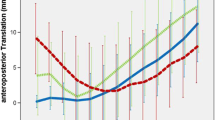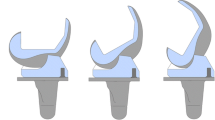Abstract
Purpose
Individual physiological knee kinematics are highly variable in normal knees and are altered following cruciate-substituting (PS) and cruciate-retaining (CR) total knee arthroplasty (TKA). We wanted to know whether knee kinematics are different choosing two different knee designs, CR and PS TKA, during surgery using computer navigation.
Methods
For this purpose, 60 consecutive TKA were randomised, receiving either CR (37 patients) or PS TKA (23 patients). All patients underwent computer navigation, and kinematics were assessed prior to making any cuts or releases and after implantation. Outcome measures were relative rotation between femur and tibia, measured medial and lateral gaps and medial and lateral condylar lift-off.
Results
We were not able to demonstrate a significant difference in femoral external rotation between either group prior to implantation (7.9° CR vs. 7.4° PS) or after implantation (9.0° CR vs. 11.3° PS), both groups showed femoral roll-back. It significantly increased pre- to postoperatively in PS TKA. In the CR group both gaps increased, the change of the medial gap was significantly attributable to medial release. In the PS group both gaps increased and the change of the medial and of the lateral gap was significant. Condylar lift-off was observed in the CR group during 20° and 60° of flexion.
Conclusion
This study did not reveal significant differences in navigation-based knee kinematics between CR and PS implants. Femoral roll-back was observed in both implant designs, but significantly increased pre- to postoperatively in PS TKA. A slight midflexion instability was observed in CR TKA. Intra-operative computer navigation can measure knee kinematics during surgery before and after TKR implantation and may assist surgeons to optimise knee kinematics or identify abnormal knee kinematics that could be corrected with ligament releases to improve the functional result of a TKR, whether it is a CR or PS design. Our intra-operative finding needs to be confirmed using fluoroscopic or radiographic 3D matching after complete recovery from surgery.



Similar content being viewed by others
References
Bourne RB, Chesworth BM, Davis AM, Mahomed NN, Charron KDJ (2010) Patient satisfaction after total knee arthroplasty: who is satisfied and who is not? Clin Orthop Relat Res 468:57–63
Lopez-Olivo MA, Landon GC, Siff SJ, Edelstein D, Pak C, Kallen MA, Stanley M, Zhang H, Robinson KC, Suarez-Almazor ME (2011) Psychosocial determinants of outcomes in knee replacement. Ann Rheum Dis 70:1775–1781
Culliton SE, Bryant DM, Overend TJ, Macdonald SJ, Chesworth BM (2011) The Relationship Between Expectations and Satisfaction in Patients Undergoing Primary Total Knee Arthroplasty. J Arthroplasty
Clarke HD, Scuderi GR (2003) Flexion instability in primary total knee replacement. J Knee Surg 16:123–128
Liu Y-L, Chen W-C, Yeh W-L, McClean CJ, Huang C-H, Lin K-J, Cheng C-K (2011) Mimicking anatomical condylar configuration into knee prosthesis could improve knee kinematics after TKA - A computational simulation. Clinical Biomechanics. Avon, Bristol
Bellemans J, Banks S, Victor J, Vandenneucker H, Moemans A (2002) Fluoroscopic analysis of the kinematics of deep flexion in total knee arthroplasty. Influence of posterior condylar offset. J Bone Joint Surg Br 84:50–53
Banks SA, Markovich GD, Hodge WA (1997) In vivo kinematics of cruciate-retaining and -substituting knee arthroplasties. J Arthroplasty 12:297–304
Massin P, Boyer P, Sabourin M (2011) Less femorotibial rotation and AP translation in deep-dished total knee arthroplasty. An intraoperative kinematic study using navigation. Knee Surg Sports Traumatol Arthrosc Off J ESSKA
Yue B, Varadarajan KM, Rubash HE, Li G (2012) In vivo function of posterior cruciate ligament before and after posterior cruciate ligament-retaining total knee arthroplasty. Int Orthop 36:1387–1392
Freeman MAR, Pinskerova V (2005) The movement of the normal tibio-femoral joint. J Biomech 38:197–208
Hill PF, Vedi V, Williams A, Iwaki H, Pinskerova V, Freeman MA (2000) Tibiofemoral movement 2: the loaded and unloaded living knee studied by MRI. J Bone Joint Surg Br 82:1196–1198
Johal P, Williams A, Wragg P, Hunt D, Gedroyc W (2005) Tibio-femoral movement in the living knee. A study of weight bearing and non-weight bearing knee kinematics using “interventional” MRI. J Biomech 38:269–276
Fitz W, Sodha S, Reichmann W, Minas T (2012) Does a modified gap-balancing technique result in medial-pivot knee kinematics in cruciate-retaining total knee arthroplasty? A pilot study. Clin Orthop Relat Res 470:91–98
Insall JN, Dorr LD, Scott RD, Scott WN (1989) Rationale of the Knee Society clinical rating system. Clin Orthop Relat Res 248:13–14
Bellamy N, Buchanan WW, Goldsmith CH, Campbell J, Stitt LW (1988) Validation study of WOMAC: a health status instrument for measuring clinically important patient relevant outcomes to antirheumatic drug therapy in patients with osteoarthritis of the hip or knee. J Rheumatol 15:1833–1840
Suggs JF, Hanson GR, Park SE, Moynihan AL, Li G (2008) Patient function after a posterior stabilizing total knee arthroplasty: cam-post engagement and knee kinematics. Knee Surg Sports Traumatol Arthrosc 16:290–296
Komistek RD, Dennis DA, Mahfouz M (2003) In vivo fluoroscopic analysis of the normal human knee. Clin Orthop Relat Res 69–81
Mahfouz MR, Komistek RD, Dennis DA, Hoff WA (2004) In vivo assessment of the kinematics in normal and anterior cruciate ligament-deficient knees. J Bone Joint Surg Am 86-A(Suppl 2):56–61
Dennis DA, Mahfouz MR, Komistek RD, Hoff W (2005) In vivo determination of normal and anterior cruciate ligament-deficient knee kinematics. J Biomech 38:241–253
Li G, Moses JM, Papannagari R, Pathare NP, DeFrate LE, Gill TJ (2006) Anterior cruciate ligament deficiency alters the in vivo motion of the tibiofemoral cartilage contact points in both the anteroposterior and mediolateral directions. J Bone Joint Surg Am 88:1826–1834
Casino D, Martelli S, Zaffagnini S, Lopomo N, Iacono F, Bignozzi S, Visani A, Marcacci M (2009) Knee stability before and after total and unicondylar knee replacement: in vivo kinematic evaluation utilizing navigation. J Orthop Res 27:202–207
Dennis DA, Komistek RD, Mahfouz MR, Walker SA, Tucker A (2004) A multicenter analysis of axial femorotibial rotation after total knee arthroplasty. Clin Orthop Relat Res 180–189
Sumino T, Gadikota HR, Varadarajan KM, Kwon Y-M, Rubash HE, Li G (2011) Do high flexion posterior stabilised total knee arthroplasty designs increase knee flexion? A meta analysis. Int Orthop 35:1309–1319
Dennis DA, Komistek RD, Mahfouz MR, Haas BD, Stiehl JB (2003) Multicenter determination of in vivo kinematics after total knee arthroplasty. Clin Orthop Relat Res 37–57
Dennis DA, Komistek RD, Colwell CE Jr, Ranawat CS, Scott RD, Thornhill TS, Lapp MA (1998) In vivo anteroposterior femorotibial translation of total knee arthroplasty: a multicenter analysis. Clin Orthop Relat Res 47–57
Victor J, Banks S, Bellemans J (2005) Kinematics of posterior cruciate ligament-retaining and -substituting total knee arthroplasty: a prospective randomised outcome study. J Bone Joint Surg Br 87:646–655
Bertin KC, Komistek RD, Dennis DA, Hoff WA, Anderson DT, Langer T (2002) In vivo determination of posterior femoral rollback for subjects having a NexGen posterior cruciate-retaining total knee arthroplasty. J Arthroplasty 17:1040–1048
Schmidt R, Komistek RD, Blaha JD, Penenberg BL, Maloney WJ (2003) Fluoroscopic analyses of cruciate-retaining and medial pivot knee implants. Clin Orthop Relat Res 139–147
Li G, Most E, Otterberg E, Sabbag K, Zayontz S, Johnson T, Rubash H (2002) Biomechanics of posterior-substituting total knee arthroplasty: an in vitro study. Clin Orthop Relat Res 214–225
Li G, Zayontz S, DeFrate LE, Most E, Suggs JF, Rubash HE (2004) Kinematics of the knee at high flexion angles: an in vitro investigation. J Orthop Res 22:90–95
Moynihan AL, Varadarajan KM, Hanson GR, Park S-E, Nha KW, Suggs JF, Johnson T, Li G (2010) In vivo knee kinematics during high flexion after a posterior-substituting total knee arthroplasty. Int Orthop 34:497–503
Dennis DA, Komistek RD, Walker SA, Cheal EJ, Stiehl JB (2001) Femoral condylar lift-off in vivo in total knee arthroplasty. J Bone Joint Surg Br 83:33–39
Schnurr C, Eysel P, König DP (2012) Is the effect of a posterior cruciate ligament resection in total knee arthroplasty predictable? Int Orthop 36:83–88
Acknowledgments
We would like to thank Mr Sven Buhk for his support and great convenience and work throughout the study.
Author information
Authors and Affiliations
Corresponding author
Rights and permissions
About this article
Cite this article
Baier, C., Springorum, HR., Götz, J. et al. Comparing navigation-based in vivo knee kinematics pre- and postoperatively between a cruciate-retaining and a cruciate-substituting implant. International Orthopaedics (SICOT) 37, 407–414 (2013). https://doi.org/10.1007/s00264-013-1798-4
Received:
Accepted:
Published:
Issue Date:
DOI: https://doi.org/10.1007/s00264-013-1798-4




